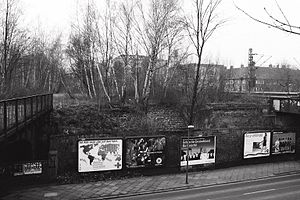Dortmund Süd train station
| Dortmund South | |
|---|---|
 The remains of the train station on Heiligen Weg
(remains of the staircase behind the billboards), KWE on the right (in operation), RhE on the left (closed) |
|
| Data | |
| abbreviation | EDOS |
| location | |
| City / municipality | Dortmund |
| country | North Rhine-Westphalia |
| Country | Germany |
| Coordinates | 51 ° 30 '31 " N , 7 ° 28' 29" E |
| Railway lines | |
| Railway stations in North Rhine-Westphalia | |
The Dortmund South Station is a 1,963 abandoned passenger train station in Dortmund . It was opened in 1874 as the Rheinischer Bahnhof Dortmund (Dortmund RhE) and in 1876 as the Westfälischer Bahnhof Dortmund (Dortmund KWE) as a double station for two private railway companies. The station facilities were later combined and, as Dortmund Süd station or Rheinisch-Westfälischer Bahnhof station, were the most important stop in the Dortmund city area alongside the main station . The Dortmund Süd station also had a depot .
history
Because the lines of the Rheinische Eisenbahn-Gesellschaft (RhE) and the Königlich-Westfälische Eisenbahn-Gesellschaft (KWE) are not connected to the existing train station of the Köln-Mindener Eisenbahn-Gesellschaft and the Bergisch-Märkische Eisenbahn-Gesellschaft (today's Dortmund Central Station) were able to, both companies built their stations southeast of Dortmund city center on what was then an open area between Märkische Strasse and Vosskuhle. The northern railway systems of the Dortmund KWE station were initially separated from the southern ones of the Dortmund RhE station - apart from three level crossings.
A few months after the Düsseldorf-Derendorf-Dortmund Süd railway line went into operation , the RhE was nationalized in 1880. Since the KWE was owned by the state from the start, all railway facilities in Dortmund Süd became the property of the Prussian state. In the decades up to the Second World War , Dortmund Süd handled both freight and passenger traffic, including direct connections to Berlin, Leipzig and Dresden via the eastern stretch of the former KWE.
In 1926, as part of an expansion of the depot, the striking water tower of Dortmund's south station , which has been preserved to this day, was built.
In the war years 1939–1945, many special trains were dispatched as part of the so-called Kinderlandverschickung .
The deportation of German Jews from Dortmund and, for example, other parts of the Arnsberg administrative district to ghettos and extermination camps took place via the Dortmund Südbahnhof. A memorial plaque on the water tower reminds of this today. The gym of the sports club Eintracht Dortmund (today about the seat of the Continental insurance) served as a collection point .
On March 12, 1945, the Südbahnhof was completely destroyed by one of the largest British air raids on Dortmund. Provisional rail operations were resumed shortly afterwards, but could never match the pre-war traffic volume. In 1957 the connection of the line to Herdecke and Hagen was shut down, since then this line has flowed over a short connecting curve past the Westfalenhalle into the line of the former Bergisch-Märkische Eisenbahn to Dortmund Central Station. With the timetable 1963, the station Dortmund South disappeared permanently from the schedules.
The railway line through the south of Dortmund city center was revived for passenger traffic in the 1960s with the advance service of today's S-Bahn line S 4 from Unna to Lütgendortmund . Instead of the south train station, however, there was the more conveniently located western stop Dortmund Stadthaus , which today also offers a connection to Dortmund's light rail network .
The station was still used for freight traffic. Most of the tracks have now been removed. In 2019 there is only one siding available.
Today only the water tower and the structural remains of the roundhouse east of the Holy Way as well as the overgrown unused staircases on the west side of the street between the railway bridges remind of the importance of this station.
See also
Web links
- Dortmund Südbahnhof on railhoo.de
- Dortmund Südbahnhof on bunker-dortmund.de
Individual evidence
- ↑ From Dortmund to Hell. WAZ, April 27, 2012


